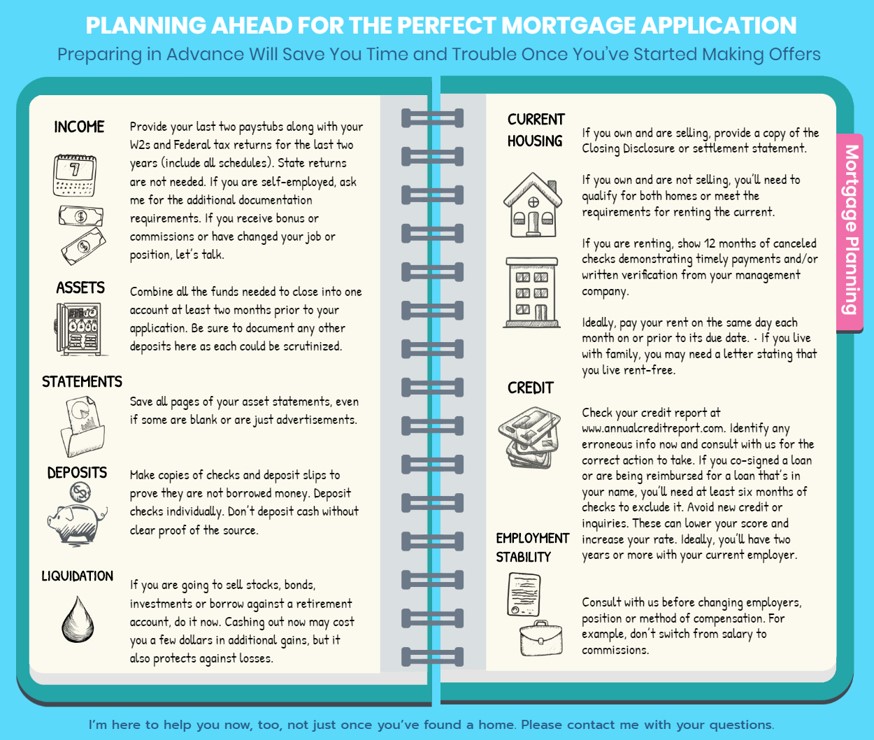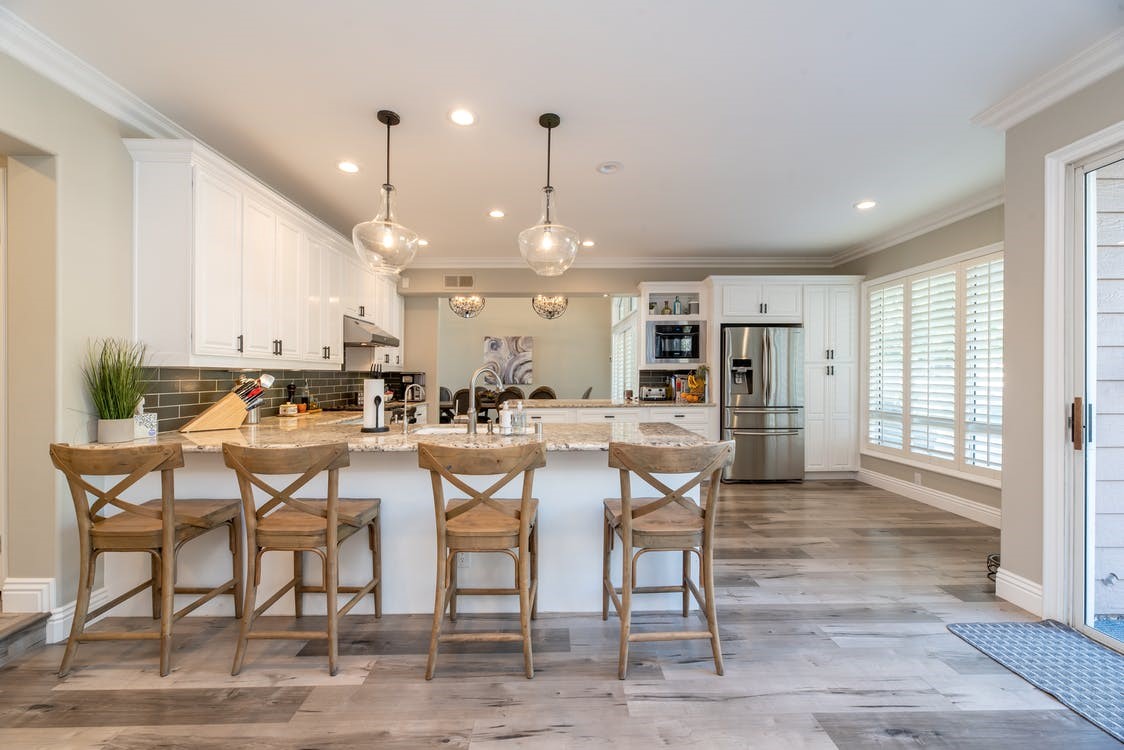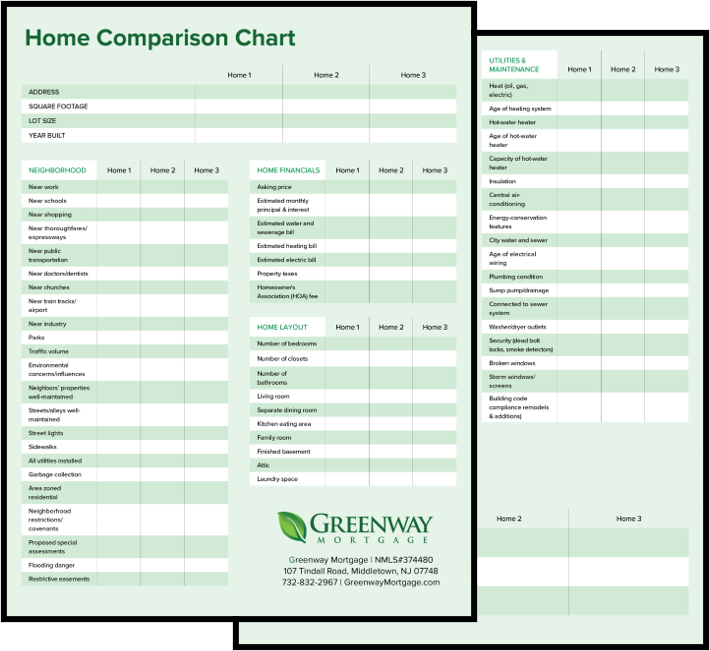

Download Your Free Home Comparison Chart Here.
Purchasing a home is a major milestone that tops many people's lifetime to-do lists—and maybe their list of financial fears too. But it certainly doesn't have to be a scary or stressful experience. With time, care, and research, you can take control of the home-buying process.
When looking for a home to buy, it becomes easy to get individual houses confused with one another because there are so many details. That's why Greenway Mortgage has created a Home Comparison Chart to help keep everything in order!
Our handy checklist identifies important factors to consider when choosing a home. In addition to an affordable sales price, you will also want to be sure that the neighborhood and house meets your needs.
Download and take this checklist along with you when you are house hunting. It will help you to evaluate the neighborhoods and assess the availability and condition of various features of up to three homes in a side-by-side comparison.

Planning ahead for your mortgage application will save you time and trouble once you start making offers. Here's a list of things you'll need to gather!
Income
- Provide your last two paystubs along with your W2s and Federal tax returns for the last two years (include all schedules). State returns are not needed.
- If you are self-employed, ask me for the additional documentation requirements.
- If you receive bonus or commissions or have changed your job or position, let’s talk.
Assets
- Combine all the funds needed to close into one account at least two months prior to your application.
- Document any other deposits here as each could be scrutinized.
Your Statements
- Save all pages of your asset statements, even if some are blank or are just advertisements.
Deposits
- Deposit checks individually.
- Don’t deposit cash without clear proof of the source.
Liquidation
- If you are going to sell stocks, bonds, investments or borrow against a retirement account, do it now. Cashing out now may cost you a few dollars in additional gains, but it also protects against losses.
Current Housing
- If you own and are selling, provide a copy of the HUD-1 settlement statement.
- If you own and are not selling, you'll need to qualify for both homes or meet the requirements for renting the current.
- If you are renting, show 12 months of canceled checks demonstrating timely payments and/or written verification from your management company. Ideally, pay your rent on the same day each month on or prior to its due date.
- If you live with family, you may need a letter stating that you live rent-free.
Credit
- Check your credit report at www.annualcreditreport.com. Identify any errors now and consult with us for the correct action to take.
- If you co-signed a loan or are being reimbursed for a loan that’s in your name, you’ll need at least six months of checks to exclude it.
- Avoid new credit or inquiries. These can lower your score and increase your rate.
Employment Stability
- Ideally, you’ll have two years or more with your current employer.
- Consult with us before changing employers, position or method of compensation. For example, don't switch from salary to commissions.

Have questions? Reach out to the Greenway Mortgage Team! We are here to help. And if you're ready to get started - click here to apply online! Start closing your loan in about 15 minutes with our easy online application!
Resources:

.jpg)
 buyers around.
buyers around.
.png)
.png) impression. You can repaint your front door to brighten and refresh your home’s exterior. If you want to spend more money, you can opt to replace the door to a more modern style.
impression. You can repaint your front door to brighten and refresh your home’s exterior. If you want to spend more money, you can opt to replace the door to a more modern style.
-
Garden
-
Sunroom
-
Backyard Patio
-
Outdoor Kitchen
-
Deck Area
 , and then seal with a protective sealer.
, and then seal with a protective sealer.
June is National Homeownership Month, a time to celebrate the benefits that homeownership brings to families, neighborhoods, and communities across America. Not only does homeownership change lives and enhance futures, it is part of the American Dream.
To this day, there continues to be a noticeable shift from renting to homeownership, especially among young buyers. It's a way for people to increase their wealth and home equity. Keep reading to learn about some of the key benefits that homeownership has to offer.
How Did Homeownership Month Start?
National Homeownership Month started as a week-long celebration of homeownership during the Clinton administration in 1995. In 2002, President George W. Bush proclaimed June as the National Homeownership Month. Today, the mortgage industry continues the message of helping people realize the dream of responsible homeownership.
-
Provides stability.
-
Creates positive environments for families.
-
Improves neighborhoods.
-
Homeowners are more involved in civic affairs, including voting in the last election and knowing their elected officials.
-
Builds wealth.
-
Provides possible tax benefits.
-
Know your credit score. Having a healthy credit score is vital to the home buying process. Figure out where your credit score stands and strategize some improvements, if necessary.
-
Build your savings. Home buyers will need money available for a down payment and closing costs. This is a great time sit down and get real about your financials. Make a budget, create a timeline and set yourself some saving goals.
-
Figure out your price range. Once you have a handle on your financial situation, the next step is to determine out how much money you can spend. Keep this number in mind when you meet with your real estate agent and Greenway Mortgage Loan Officer.
-
Do your research. Research the area you would like to purchase your home. Take note of school districts, commute times, nearby parks or shopping, and any other things you feel are important to you.
-
Find a real estate agent. It is important to have a trusted real estate agent by your side during your home buying journey. Find someone you can rely on and feel comfortable with.
-
Get your documents in order. A lot of paperwork goes into getting a home loan. Come out on top by getting organized and locating necessary papers ahead of time. Have on hand recent paystubs, W-2s from the past 2 years, recent tax returns and bank and asset statements.
-
Meet with a Greenway Loan Officer. It is crucial to meet with a lender to get pre-approved for a home loan so you know how much home you can afford. This should always be step #1. Also, having a pre-approval letter puts you at an advantage when dealing with a potential seller, as he or she will know you’re one step closer to getting a mortgage.
-
FREE First-Time Home Buyer eBOOK – includes handy resources & checklists
-
First-Time Home Buyer RESOURCES – check out our first-time buyer programs!
-
Buying Your First Home – learn everything you need to know!
-
Mortgage Videos – learn about the mortgage process, programs & more
-
Mortgage Calculators – we have an entire library of easy-to-use calculators!
-
Mortgage Terms – get up to speed on some mortgage terminology
-
Ready to get started? Apply Now using our online application.
Greenway Mortgage is proud to be a part of the industry that makes homeownership a reality for so many Americans! When you’re ready to get your journey started, reach out to us!

-
Your Savings Goals
-
Monthly Payments (rent, utilities, car payments, student loans, etc)
-
Weekly Spending (gas groceries, entertainment)





.jpg)
